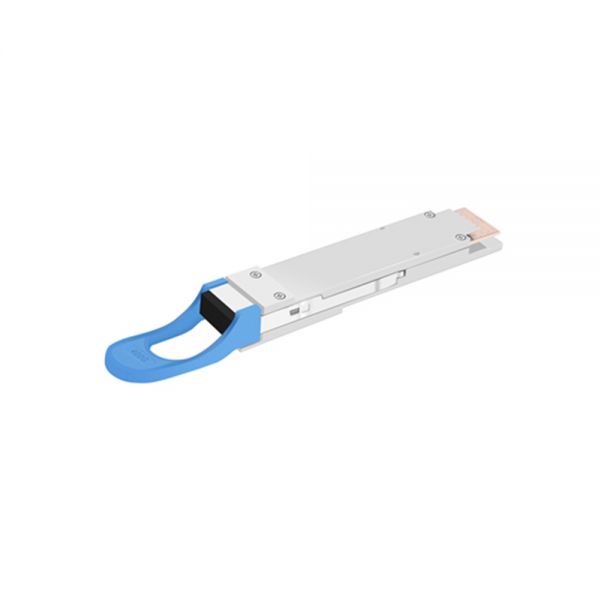
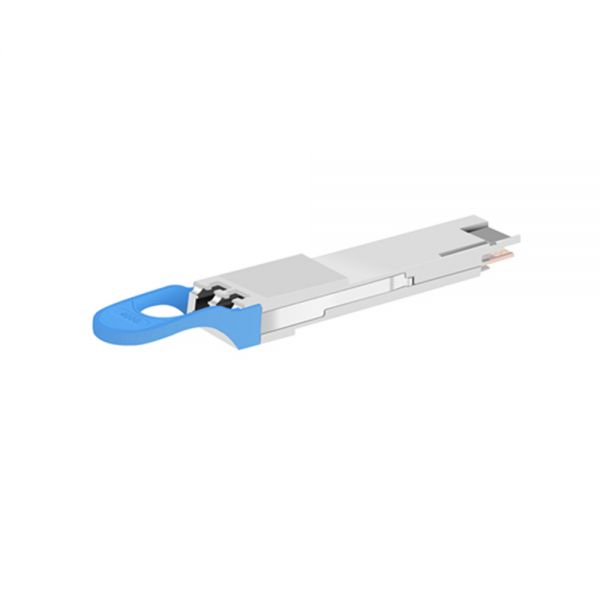
This product is a 400Gb/s Quad Small Form Factor Pluggable-double density (QSFP-DD) optical module designed for 2km optical communication applications.


This product is a 400Gb/s Quad Small Form Factor Pluggable-double density (QSFP-DD) optical module designed for 2km optical communication applications.
Features
● QSFP-DD MSA compliantTransceiver Block Diagram
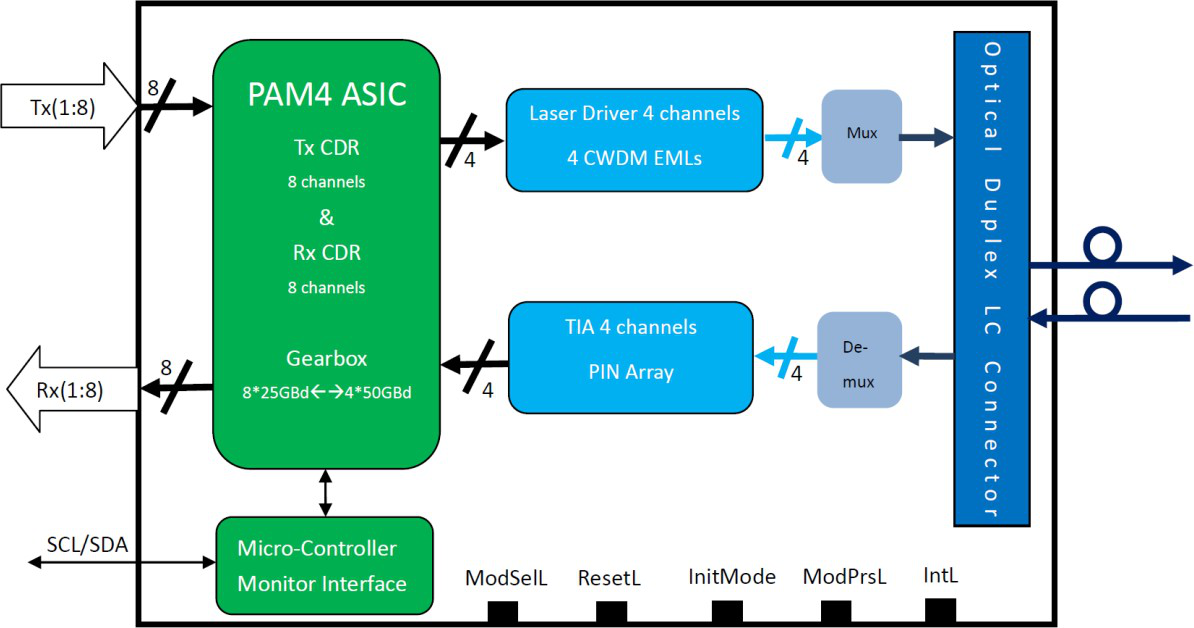
Figure 1. Transceiver Block Diagram
The electrical pinout of the QSFP-DD module is shown in Figure 2 below.
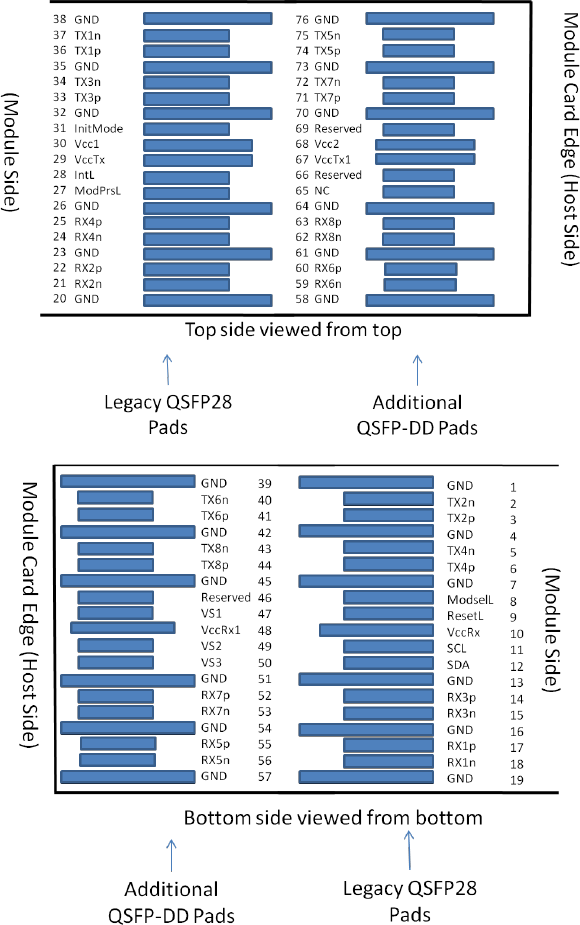
Pin Definition
|
Pin |
Logic |
Symbol |
Deion |
Plug Sequence |
Notes |
|
1 |
|
GND |
Ground |
1B |
1 |
|
2 |
CML-I |
Tx2n |
Transmitter Inverted Data Input |
3B |
|
|
3 |
CML-I |
Tx2p |
Transmitter Non-Inverted Data
Input |
3B |
|
|
4 |
|
GND |
Ground |
1B |
1 |
|
5 |
CML-I |
Tx4n |
Transmitter Inverted Data Input |
3B |
|
|
6 |
CML-I |
Tx4p |
Transmitter Non-Inverted Data Input |
3B |
|
|
7 |
|
GND |
Ground |
1B |
1 |
|
8 |
LVTTL-I |
ModSelL |
Module Select |
3B |
|
|
9 |
LVTTL-I |
ResetL |
Module Reset |
3B |
|
|
10 |
|
VccRx |
+3.3V Power Supply Receiver |
2B |
2 |
|
11 |
LVCMOS-
I/O |
SCL |
2-wire serial interface clock |
3B |
|
|
12 |
LVCMOS-
I/O |
SDA |
2-wire serial interface data |
3B |
|
|
13 |
|
GND |
Ground |
1B |
1 |
|
14 |
CML-O |
Rx3p |
Receiver Non-Inverted Data Output |
3B |
|
|
15 |
CML-O |
Rx3n |
Receiver Inverted Data Output |
3B |
|
|
16 |
GND |
Ground |
1B |
|
1 |
|
17 |
CML-O |
Rx1p |
Receiver Non-Inverted Data Output |
3B |
|
|
18 |
CML-O |
Rx1n |
Receiver Inverted Data Output |
3B |
|
|
19 |
|
GND |
Ground |
1B |
1 |
|
20 |
|
GND |
Ground |
1B |
1 |
|
21 |
CML-O |
Rx2n |
Receiver Inverted Data Output |
3B |
|
|
22 |
CML-O |
Rx2p |
Receiver Non-Inverted Data Output |
3B |
|
|
23 |
|
GND |
Ground |
1B |
1 |
|
24 |
CML-O |
Rx4n |
Receiver Inverted Data Output |
3B |
|
|
25 |
CML-O |
Rx4p |
Receiver Non-Inverted Data Output |
3B |
|
|
26 |
|
GND |
Ground |
1B |
1 |
|
27 |
LVTTL-O |
ModPrsL |
Module Present |
3B |
|
|
28 |
LVTTL-O |
IntL |
Interrupt |
3B |
|
|
29 |
|
VccTx |
+3.3V Power supply transmitter |
2B |
2 |
|
30 |
|
Vcc1 |
+3.3V Power supply |
2B |
2 |
|
31 |
LVTTL-I |
InitMode |
Initialization mode; In legacy QSFP
applications, the InitMode pad is called LPMODE |
3B |
|
|
32 |
|
GND |
Ground |
1B |
1 |
|
33 |
CML-I |
Tx3p |
Transmitter Non-Inverted Data
Input |
3B |
|
|
34 |
CML-I |
Tx3n |
Transmitter Inverted Data Input |
3B |
|
|
35 |
|
GND |
Ground |
1B |
1 |
|
36 |
CML-I |
Tx1p |
Transmitter Non-Inverted Data
Input |
3B |
|
|
37 |
CML-I |
Tx1n |
Transmitter Inverted Data Input |
3B |
|
|
38 |
|
GND |
Ground |
1B |
1 |
|
39 |
|
GND |
Ground |
1A |
1 |
|
40 |
CML-I |
Tx6n |
Transmitter Inverted Data Input |
3A |
|
|
41 |
CML-I |
Tx6p |
Transmitter Non-Inverted Data
Input |
3A |
|
|
42 |
|
GND |
Ground |
1A |
1 |
|
43 |
CML-I |
Tx8n |
Transmitter Inverted Data Input |
3A |
|
|
44 |
CML-I |
Tx8p |
Transmitter Non-Inverted Data
Input |
3A |
|
|
45 |
|
GND |
Ground |
1A |
1 |
|
46 |
|
Reserved |
For future use |
3A |
3 |
|
47 |
|
VS1 |
Module Vendor Specific 1 |
3A |
3 |
|
48 |
|
VccRx1 |
3.3V Power Supply |
2A |
2 |
|
49 |
|
VS2 |
Module Vendor Specific 2 |
3A |
3 |
|
50 |
|
VS3 |
Module Vendor Specific 3 |
3A |
3 |
|
51 |
|
GND |
Ground |
1A |
1 |
|
52 |
CML-O |
Rx7p |
Receiver Non-Inverted Data Output |
3A |
|
|
53 |
CML-O |
Rx7n |
Receiver Inverted Data Output |
3A |
|
|
54 |
|
GND |
Ground |
1A |
1 |
|
55 |
CML-O |
Rx5p |
Receiver Non-Inverted Data Output |
3A |
|
|
56 |
CML-O |
Rx5n |
Receiver Inverted Data Output |
3A |
|
|
57 |
|
GND |
Ground |
1A |
1 |
|
58 |
|
GND |
Ground |
1A |
1 |
|
59 |
CML-O |
Rx6n |
Receiver Inverted Data Output |
3A |
|
|
60 |
CML-O |
Rx6p |
Receiver Non-Inverted Data Output |
3A |
|
|
61 |
|
GND |
Ground |
1A |
1 |
|
62 |
CML-O |
Rx8n |
Receiver Inverted Data Output |
3A |
|
|
63 |
CML-O |
Rx8p |
Receiver Non-Inverted Data Output |
3A |
|
|
64 |
|
GND |
Ground |
1A |
1 |
|
65 |
|
NC |
No Connect |
3A |
3 |
|
66 |
|
Reserved |
For future use |
3A |
3 |
|
67 |
|
VccTx1 |
3.3V Power Supply |
2A |
2 |
|
68 |
|
Vcc2 |
3.3V Power Supply |
2A |
2 |
|
69 |
|
Reserved |
For Future Use |
3A |
3 |
|
70 |
|
GND |
Ground |
1A |
1 |
|
71 |
CML-I |
Tx7p |
Transmitter Non-Inverted Data Input |
3A |
|
|
72 |
CML-I |
Tx7n |
Transmitter Inverted Data Input |
3A |
|
|
73 |
|
GND |
Ground |
1A |
1 |
|
74 |
CML-I |
Tx5p |
Transmitter Non-Inverted Data Input |
3A |
|
|
75 |
CML-I |
Tx5n |
Transmitter Inverted Data Input |
3A |
|
|
76 |
|
GND |
Ground |
1A |
1 |
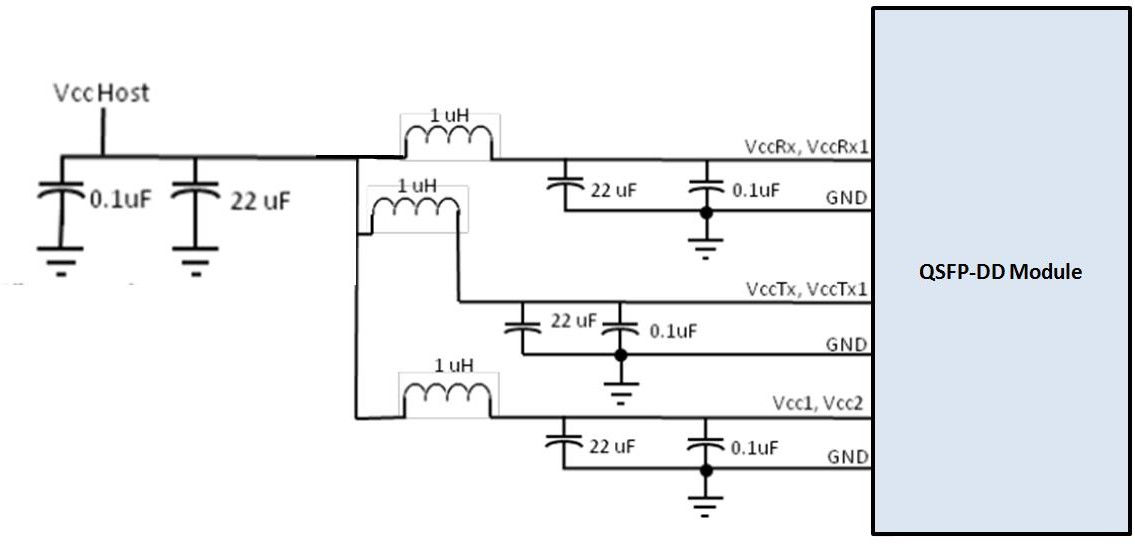
Figure 3. Recommended Power Supply Filter
It has to be noted that the operation in excess of any individual absolute maximum ratings might cause permanent damage to this module.
Recommended Operating Conditions and Power Supply Requirements
|
Parameter |
Symbol |
Min |
Typical |
Max |
Units |
Notes |
|
Operating Case Temperature |
TOP |
0 |
|
70 |
degC |
|
|
Power Supply Voltage |
VCC |
3.135 |
3.3 |
3.465 |
V |
|
|
Data Rate, each Lane |
|
|
26.5625 |
|
GBd |
PAM4 |
|
Data Rate Accuracy |
|
-100 |
|
100 |
ppm |
|
|
Pre-FEC Bit Error Ratio |
|
|
|
2.4x10-4 |
|
|
|
Post-FEC Bit Error Ratio |
|
|
|
1x10-12 |
|
1 |
|
Link Distance |
D |
0.002 |
|
2 |
km |
2 |
Notes:
1. FEC provided by host system.
2. FEC required on host system to support maximum distance.
Electrical Characteristics
The following electrical acteristics are defined over the Recommended Operating Environment unless otherwise specified.
|
Parameter |
Test
Point |
Min |
Typical |
Max |
Units |
Notes |
|||||||
|
Power Consumption |
|
|
|
12 |
W |
|
|||||||
|
Supply Current |
Icc |
|
|
3.63 |
A |
|
|||||||
|
Transmitter (each Lane) |
|||||||||||||
|
Signaling Rate, each Lane |
TP1 |
26.5625 ± 100 ppm |
GBd |
|
|||||||||
|
Differential pk-pk Input Voltage Tolerance |
TP1a |
900 |
|
|
mVpp |
1 |
|||||||
|
Differential Termination Mismatch |
TP1 |
|
|
10 |
% |
|
|||||||
|
Differential Input Return Loss |
TP1 |
IEEE 802.3-
2015
Equation
(83E-5) |
|
|
dB |
|
|||||||
|
Differential to Common Mode Input Return Loss |
TP1 |
IEEE 802.3-
2015
Equation
(83E-6) |
|
|
dB |
|
|||||||
|
Module Stressed Input Test |
TP1a |
See IEEE 802.3bs 120E.3.4.1
|
|
2 |
|||||||||
|
Single-ended Voltage Tolerance Range (Min) |
TP1a |
-0.4 to 3.3 |
V |
|
|||||||||
|
DC Common Mode Input Voltage |
TP1 |
-350 |
|
2850 |
mV |
3 |
|||||||
|
Receiver (each Lane) |
|||||||||||||
|
Signaling Rate, each lane |
TP4 |
26.5625 ± 100 ppm |
GBd |
|
|||||||||
|
Differential Peak-to-Peak Output Voltage |
TP4 |
|
|
900 |
mVpp |
|
|||||||
|
AC Common Mode Output Voltage, RMS |
TP4 |
|
|
17.5 |
mV |
|
|||||||
|
Differential Termination Mismatch |
TP4 |
|
|
10 |
% |
|
|||||||
|
Differential Output Return Loss |
TP4 |
IEEE 802.3-
2015
Equation
(83E-2) |
|
|
|
|
|||||||
|
Common to Differential Mode Conversion Return Loss |
TP4 |
IEEE 802.3-
2015
Equation
(83E-3) |
|
|
|
|
|||||||
|
Transition Time, 20% to 80% |
TP4 |
9.5 |
|
|
ps |
|
|||||||
|
Near-end Eye Symmetry Mask
Width (ESMW) |
TP4 |
|
0.265 |
|
UI |
|
|||||||
|
Near-end Eye Height,
Differential |
TP4 |
70 |
|
|
mV |
|
|||||||
|
Far-end Eye Symmetry Mask
Width (ESMW) |
TP4 |
|
0.2 |
|
UI |
|
|||||||
|
Far-end Eye Height, Differential |
TP4 |
30 |
|
|
mV |
|
|||||||
|
Far-end Pre-cursor ISI Ratio |
TP4 |
-4.5 |
|
2.5 |
% |
|
|||||||
|
Common Mode Output Voltage (Vcm) |
TP4 |
-350 |
|
2850 |
mV |
3 |
|||||||
Notes:
1. With the exception to IEEE 802.3bs 120E.3.1.2 that the pattern is PRBS31Q or scrambled idle.
2. Meets BER specified in IEEE 802.3bs 120E.1.1.
3. DC common mode voltage generated by the host. Specification includes effects of ground offset voltage.
Optical Characteristics
|
Parameter |
Symbol |
Min |
Typical |
Max |
Units |
Notes |
|
||||||
|
Wavelength Assignment |
L0 |
1264.5 |
1271 |
1277.5 |
nm |
|
|
||||||
|
L1 |
1284.5 |
1291 |
1297.5 |
nm |
|
|
|||||||
|
L2 |
1304.5 |
1311 |
1317.5 |
nm |
|
|
|||||||
|
L3 |
1324.5 |
1331 |
1337.5 |
nm |
|
|
|||||||
|
Transmitter |
|
||||||||||||
|
Data Rate, each Lane |
|
53.125 ± 100 ppm |
GBd |
|
|
||||||||
|
Modulation Format |
|
PAM4 |
|
|
|
||||||||
|
Side-mode Suppression Ratio |
SMSR |
30 |
|
|
dB |
|
|
||||||
|
Total Average Launch Power |
PT |
|
|
9.3 |
dBm |
|
|
||||||
|
Average Launch Power, each Lane |
PAVG |
-3.3 |
|
3.5 |
dBm |
1 |
|
||||||
|
Outer Optical Modulation
Amplitude (OMAouter), each Lane |
POMA |
-0.3 |
|
3.7 |
dBm |
2 |
|
||||||
|
Launch Power in OMAouter minus TDECQ, each Lane
for ER ≥ 4.5dB
for ER < 4.5dB |
|
-1.7
-1.6 |
|
|
dB |
|
|
||||||
|
Transmitter and Dispersion Eye Closure for PAM4, each Lane |
TDECQ |
|
|
3.4 |
dB |
|
|
||||||
|
TDECQ – 10*log10(Ceq), each Lane |
|
|
|
3.4 |
dB |
3 |
|
||||||
|
Extinction Ratio |
ER |
3.5 |
|
|
dB |
|
|
||||||
|
Difference in Launch Power between any Two Lanes
(OMAouter) |
|
|
|
4 |
dB |
|
|
||||||
|
RIN17.1OMA |
RIN |
|
|
-136 |
dB/Hz |
|
|
||||||
|
Optical Return Loss Tolerance |
TOL |
|
|
17.1 |
dB |
|
|
||||||
|
Transmitter Reflectance |
RT |
|
|
-26 |
dB |
|
|
||||||
|
Transmitter Transition Time |
|
|
|
17 |
ps |
|
|
||||||
|
Average Launch Power of OFF Transmitter, each Lane |
Poff |
|
|
-20 |
dBm |
|
|
||||||
|
Receiver |
|
||||||||||||
|
Data Rate, each Lane |
|
53.125 ± 100 ppm |
GBd |
|
|
||||||||
|
Modulation Format |
|
PAM4 |
|
|
|||||||||
|
Damage Threshold, each Lane |
THd |
4.5 |
|
|
dBm |
4 |
|||||||
|
Average Receive Power, each Lane |
|
-7.3 |
|
3.5 |
dBm |
5 |
|||||||
|
Receive Power (OMAouter), each Lane |
|
|
|
3.7 |
dBm |
|
|||||||
|
Difference in Receiver Power between any Two Lanes
(OMAouter) |
|
|
|
4.1 |
dB |
|
|||||||
|
Receiver Sensitivity (OMAouter), each Lane |
SEN |
|
|
Equation (1) |
dBm |
6 |
|||||||
|
Stressed Receiver Sensitivity
(OMAouter), each Lane |
SRS |
|
|
-2.6 |
dBm |
7 |
|||||||
|
Receiver Reflectance |
RR |
|
|
-26 |
dB |
|
|||||||
|
LOS Assert |
LOSA |
-20 |
|
|
dBm |
|
|||||||
|
LOS De-assert |
LOSD |
|
|
-10.3 |
dBm |
|
|||||||
|
LOS Hysteresis |
LOSH |
0.5 |
|
|
dB |
|
|||||||
|
Stressed Conditions for Stress Receiver Sensitivity (Note 8) |
|||||||||||||
|
Stressed Eye Closure for PAM4
(SECQ), Lane under Test |
|
|
3.4 |
|
dB |
|
|||||||
|
SECQ – 10*log10(Ceq), Lane under Test |
|
|
|
3.4 |
dB |
|
|||||||
|
OMAouter of each Aggressor Lane |
|
|
1.5 |
|
dBm |
|
|||||||
|
Modulation Format |
|
PAM4 |
|
|
|
||||||||
|
Notes:
1. Average launch power, each lane (min) is informative and not the principal indicator of signal strength. A transmitter with launch power below this value cannot be compliant; however, a value above this does not ensure compliance.
2. Even if the TDECQ < 1.4 dB for an extinction ratio of ≥ 4.5 dB or TDECQ < 1.3 dB for an extinction ratio of < 4.5 dB, the OMAouter (min) must exceed the minimum value specified here.
3. Ceq is a coefficient defined in IEEE Std 802.3-2018 clause 121.8.5.3 which accounts for reference equalizer noise enhancement.
4. Average receive power, each lane (min) is informative and not the principal indicator of signal strength. A received power below this value cannot be compliant; however, a value above this does not ensure compliance.
5. The receiver shall be able to tolerate, without damage, continuous exposure to an optical input signal having this average power level. 6. Receiver sensitivity (OMAouter) is informative and is defined for a transmitter with a value of SECQ up to 3.4 dB. Receiver sensitivity should meet Equation (1), which is illustrated in Figure 4.
Where:
RS is the receiver sensitivity, and
SECQ is the SECQ of the transmitter used to measure the receiver sensitivity.
7. Measured with conformance test signal at TP3 for the BER equal to 2.4x10-4. |
|
||||||||||||
Digital Diagnostic Functions
The following digital diagnostic acteristics are defined over the normal operating conditions unless otherwise specified.
|
Parameter |
Symbol |
Min |
Max |
Units |
Notes |
|
Temperature Monitor Absolute Error |
DMI_Temp |
-3 |
3 |
degC |
Over operating temperature range |
|
Supply Voltage Monitor
Absolute Error |
DMI _VCC |
-0.1 |
0.1 |
V |
Over full operating
range |
|
Channel RX Power Monitor Absolute Error |
DMI_RX_Ch |
-2 |
2 |
dB |
1 |
|
Channel Bias Current
Monitor |
DMI_Ibias_Ch |
-10% |
10% |
mA |
|
|
Channel TX Power Monitor
Absolute Error |
DMI_TX_Ch |
-2 |
2 |
dB |
1 |
Notes:
1. Due to measurement accuracy of different single mode fibers, there could be an additional +/-1 dB fluctuation, or a +/- 3 dB total accuracy.
Outline Drawing (mm)
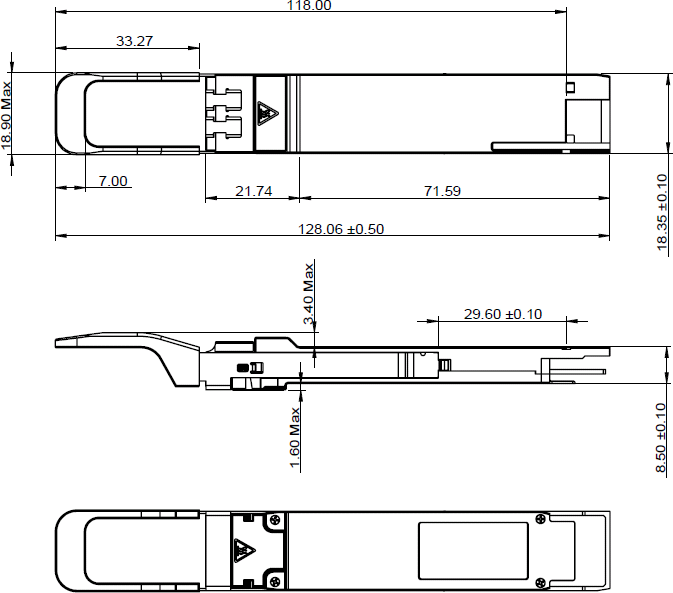
Applications
● Data Center Interconnect
● 400G Ethernet| Ordering Information |
|---|
| Date | Version | Description | Download |
|---|---|---|---|
| 2024-04-28 | V1.0 | Datasheet_400G QSFP-DD FR4 1310nm 2km_LA-OT-400G-FR4.pdf | |
| Photo | Model | Description |
|---|